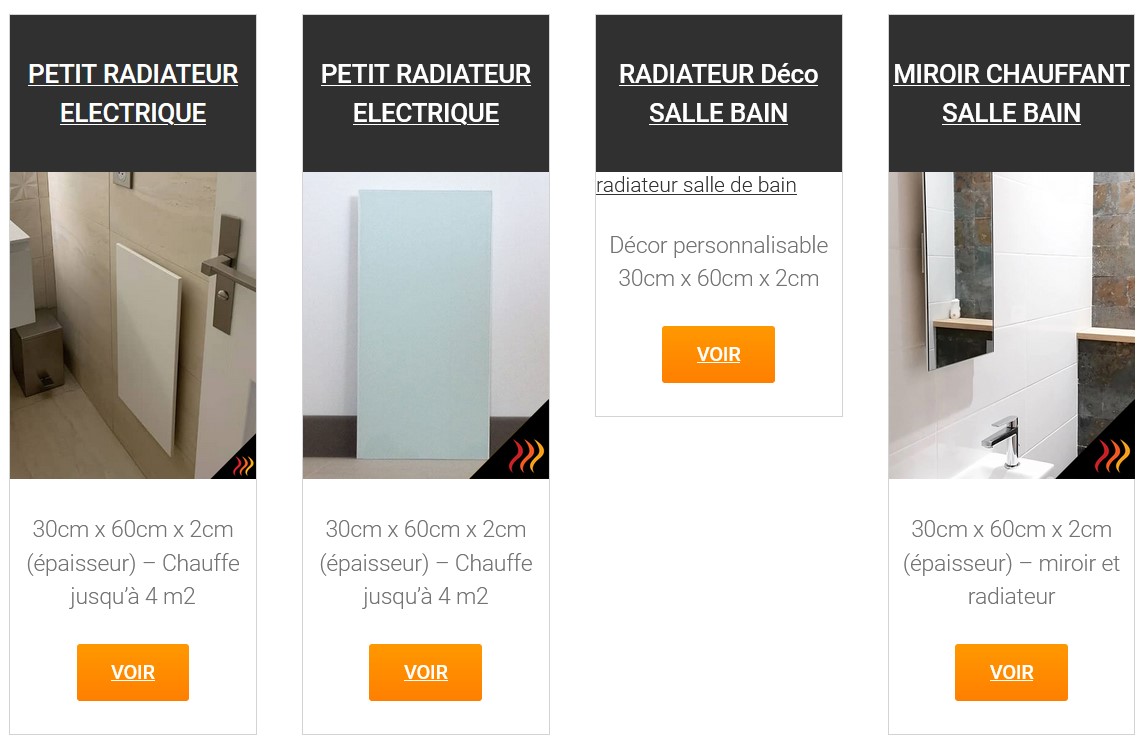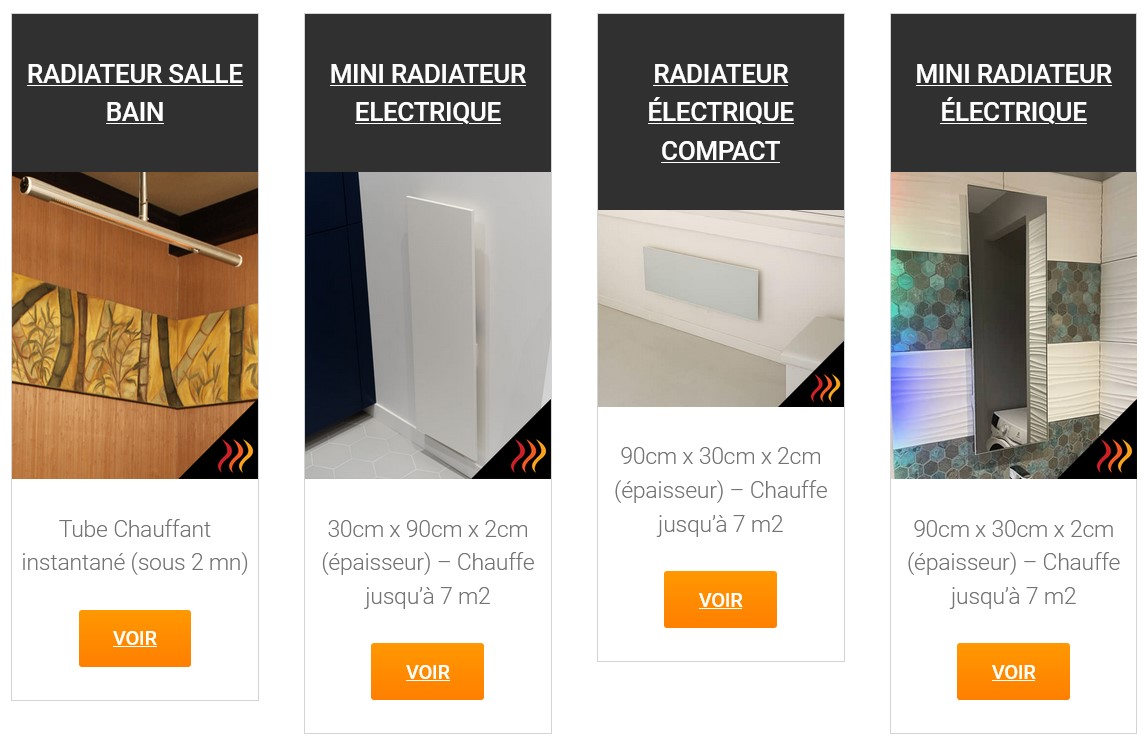Home / Heating / Electric Heating / How to choose an electric heater for a bathroom? (español – français)
How to choose an electric heater for a bathroom?
Share this page
6 essential criteria for choosing your bathroom heater
The ideal characteristics of a bathroom heater shall at the same time satisfy the following points:
- quickly provide power when it is needed (and not continuously),
- be compact and extra flat in order to meet the often significant layout constraints in small rooms,
- emit soft and enveloping heat,
- comply with the standards for electrical bathroom equipment,
- be in harmony with the style of the bathroom (therefore customisable),
- be controlled independently of the rest of the heating installation (independent thermostat),
- be able to dry towels (optional).
However, these parameters are most often contradictory… see our customised selection guide (at the end of this article).
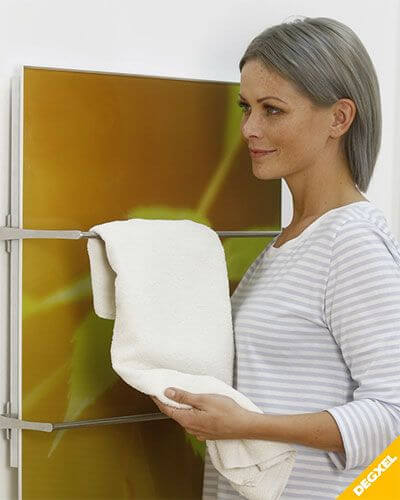
DEGXEL infrared towel dryer
Criterion n°1: quickly provide the necessary heat output to the room
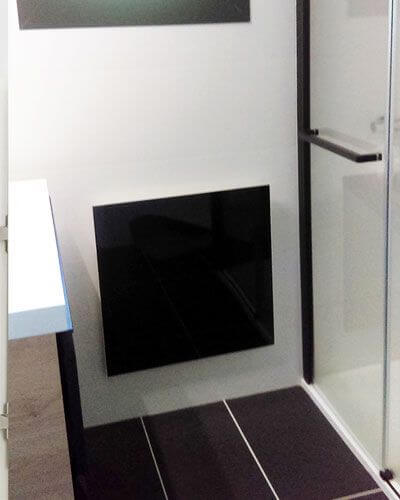
Picture credit: DEGXEL extra flat heater
When the bathroom is occupied, we generally want to have an ambient temperature of at least 22-23°C for a better feeling of comfort. When the bathroom becomes unoccupied again the recommended ambient temperature (for an inhabited accommodation) is around 18°C. Therefore, the mission of the heater is to rapidly provide an important intake of calories to pass from 18°C to 23°C.
From this point of view, not all technologies are worthy. What technology and power to choose?
Preferably, mixed heaters (mainly operating on central heating and as an electric back up when the boiler is off) are excluded, which do not have the necessary power supply. The infrared heating is recommended.
Criterion n°2: be compact and extra flat to meet layout constraints
With some exceptions (case of infrared heaters), the diffusion of gentle heat depends on the surface of the heater. Bigger the surface, better the comfort. However, the available space often prevents installing a large heater. Today, there are extra flat heaters of compact dimensions (from 30 cm wide) and different shapes (vertical, horizontal, square). These heaters can be installed on the wall or on the ceiling. See the selection guide (bellow).

Picture Credit: DEGXEL slimline heater
Criterion n°3: deliver gentle and homogeneous heat
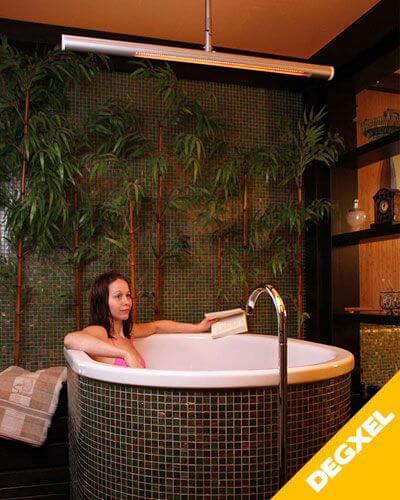
Picture Credit: instant heat – infrared tubular heater
Bathroom, room of comfort par excellence, is synonymous to well-being and thermal comfort. It is therefore essential to favor the emission of heat by radiation rather than by convection (air mixing). Blowing hot air (fan heater) via high consumption resistance it’s not the solution.
Criterion n°4: comply with existing electric standards for installation in wet rooms
The electrical regulations define applicable rules for the installation of electrical equipment in bathrooms. Class 1 heaters have an earth wire to ensure people’s protection (in the event of an insulation fault) by connecting the mass of the device to the ground. Class 2 heaters do not need earth wire as their metal part with which the users can come into contact is insulated from the electrical part of the heater. To learn more about the installation of electric heaters and towel dryers in the bathroom.
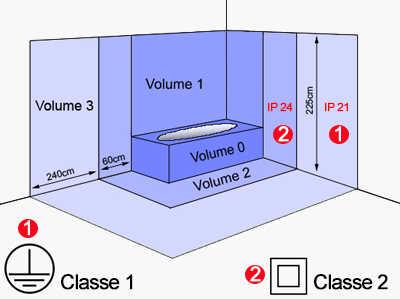
volumes to follow for the-installation of electrical devices in bathrooms and toilet
Criterion n°5: a designer heater that matches your decoration
Beyond the functionality and essential thermal characteristics of a bathroom heater, the aesthetic aspect is a criterion of choice not to be neglected. Low thickness (extra flat), positioning (wall or ceiling), multi-function (
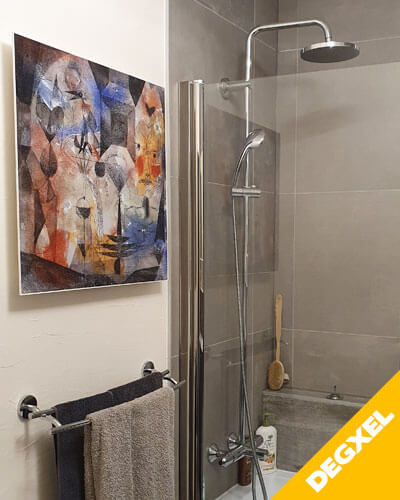
Picture Credit: DEGXEL design heater
Helping guide for choosing an electric heater for a bathroom
| – |
Additional heating? |
Heat requirements |
Lifestyle habits |
Recommended solution |
| CASE n°1 | Existing electric heating in the room | addition of + 3°C max for a short period of time | regular use | optez pour un opt for a daily programmer |
| CASE n°2 | Existing central heating in the room | addition of + 3°C max for a short period of time | regular use | opt for a high quality programmable electric radiant heater for periods when the boiler is switched off |
| CASE n°3 | Existing electric heating in the room | addition of + 3°C max for a short period of time | regular use | opt for a high quality programmable electric radiant heater to be optimally placed in the room (from 300W to 600W depending on the size of the bathroom). Depending on the ancientness of the existing heating, replace it with a radiant heater. |
| CASE n°4 | No other heating mode | addition of + 3°C max for a short period of time | regular use | opt for a high quality programmable electric radiant heater to be optimally placed in the room (from 300W to 600W depending on the size of the bathroom). |
| CASE n°5 | No other heating mode | addition of more than 3°C for a short period of time (e.g.: +4-5-6°C) | irregular use | opt for an electric short infrared heater of high power (at least 900W). It heats only a limited area of the room but in a very rapid manner (e.g. heating tubes with maximum power in less than 2 minutes) |
We can distinguish several scenarios according to occupant habits and whether or not a main heating mode exists. We start here from the assumption that it is necessary to heat a bathroom to a temperature of at least 3°C above the temperature of an unoccupied room.
Case n°1: you already have an electric heating mode (underfloor heating, electric heater), but occasionally you lack power during the short period of use of your bathroom:
- If your home has a high standard of use (always at the same time) and if the heat input does not exceed 3°C: opt for a daily programmer (different programming during the week and the weekend). According to the heat response specific to each bathroom, you will adjust the starting time of your heating (“forced operation”). The idea is not to start it too early to avoid unnecessary consumption of energy.
Case n°2: your bathroom is already heated by central heating (underfloor heating, water heater) but occasionally you lack power and you use your bathroom on regular schedules.
- The problem lies both in the need of a punctual excess of power (possible programming) but also in the management of periods when the boiler is switched-off (off-season for example).
- We therefore recommend the installation of a high-performance radiant heater (far infrared or short infrared). Well positioned in the room, it will be able to provide gentle and enveloping heat thanks to the direct radiation towards the users.
Case n°3: you already have an electric heating mode (underfloor heating, electric heater) but occasionally you lack power and you use your bathroom on variable schedules.
- In the case of an “unplanned” use. Be careful, it is rare that a heater coupled to a thermostat in BOOST mode (for example +3°C for 1h) is able to heat the room to a desired temperature within a reasonable time…
- We therefore recommend the installation of a high-performance radiant heater (far infrared or short infrared). Well positioned in the room, it will be able to provide gentle and enveloping heat thanks to the direct radiation towards the users. Infrared and/or blower strip heaters can meet the needs (technical and not aesthetic) for small bathrooms.
Case n°4: you only want one heating emitter in the room and your lifestyle habits are regular
- Therefore, you need a well-sized heater in terms of power and which provides the necessary heat output quickly (without having to heat 4h before the use). The heating may be programmable to limit the consumptions while maximising comfort.
Case n°5: you only want one heating emitter in the room and your lifestyle habits are irregular
- You therefore need a very reactive and powerful heating. This reactivity will result in a significant increase in consumption, but only for a limited period of time. The less time you spend in the bathroom, the more suitable this solution is. The more time you spend in your bathroom, the more you need to orient yourself to a heater with a programmable thermostat.
Examples of recommended electric heaters for a bathroom
In this section we present our selection of electric heaters for bathrooms. The main advantages of our selection of heaters are their very low thickness, the number of possibilities of dimensions (particularly compact dimensions), the speed of reaction to provide thermal comfort.
We present below our selection of best electric infrared heaters currently on the market according to our criteria of finish, overall quality, safety and low consumption:
- Shape of the electric heater: vertical, horizontal, square
- Positioning: wall or ceiling mounted heater, installation ultra simplified via 2 anti-releasing wall plates
- Finish: metal painted in customisable colours, tinted glass, mirror, choice of decor, …
- Extra flat: only 2 cm thick incorporating high density insulation on the back to force the radiation towards the front
- Low consumption: High efficiency infrared technology with very low power (count only 60 Watts per m2) – consumption of £1 per day maximum for the most powerful heaters. Classified as the most cost-effective heating solution over 20 years
- Safety: IP45 class 1. Manufacturer’s guarantee: 5 to 8 years. Price: from £349
Other selection of high-end electric heaters
Other topics that may be of interest to you
Learn more: What are the best heaters?
Learn more about radiation heating
Learn more about infrared heating for housing
Learn more about different heating technologies for housing
EN-FOX56



